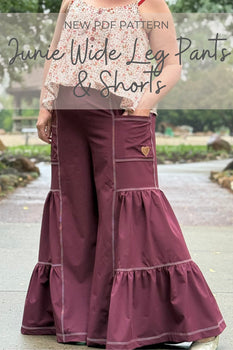
How to Make Continuous Bias Tape: Any Size, Any Length!
|
|
Time to read 3 min
DIY Bias Tape
Bias tape can be one of the most versatile sewing notions in your stash- especially if you sew a lot of wovens. It is a great way to finish necklines, hems, seams, or even used to make straps! While you can definitely purchase premade bias tape from most craft or sewing stores, there is something special about making your own and having match your project perfectly- and it's totally not that hard!
Bias tape differs from other types of binding in one main way- it's cut on the bias! Because of the way that textiles are woven there is a little bit of mechanical stretch running diagonally to the grainline- this is your bias! By cutting along the bias, you will create a fabric strip that will contour around curved areas like necklines and armscyes.
There are two main types of bias binding- single fold bias and double fold bias. Single fold bias has each of the raw edges turned in once and double fold bias has the edges folded in twice. Single fold bias is great for hems, adding stripes to your project, or finishing the necklines with a "hidden" finish with the bias tape on the inside. Double fold bias is great for finishing the edges of bulky projects (like quilts or heavy jackets), finishing seams, or creating straps on tanks and dresses. Are you ready to get started creating your own?
Let's get it!
How to calculate your bias width & lengths...
In order to calculate your bias tape lengths and widths, you need a few different measurements and a calculator- unless you're like wayyyyy better at math than me. First, determine the length of the bias tape that you need for your project and then add an additional 10-12 inches. Next you will need the width of the bias tape. For single fold bias tape you will multiply the desired finished width by 2. For double fold bias tape you will multiply the desired finished width by 4.
Once you have the lengths and widths needed you will follow the simple formula below to find the size of the square that you need to cut!
Length x Width= Area Needed in Square Inches
-then we will take the square root-
√Area= Size of the Square Needed (rounded up)
Let's see an example! If I want 2 total yards of 1/4" Double Fold Bias Tape, that math would look something like this:
72" x 1"= 72"
√72=8.48
= 9" square
If math is just not your thing, you can check out the bias tape cheat sheet below!
a PDF sewing pattern

Making your Bias Tape

- Step 1: Cut a square of fabric based on the amount you need from the chart above.
- Step 2: Using a straight edge ruler cut diagonally between the corners of the fabric.

- Step 3: Place the pieces right sides up and match opposite sides of the square, either top to bottom or left to right.
- Step 4: Flip the pieces over right sides together and match along the edge. Adjust to where there is a 1/4" overhang on each end. Pin and sew with a 1/4" seam allowance.

- Step 5: Press the seam allowance open and rotate the piece as sewn. Using your straight edge or ruler, trace lines straight across using the wrong side of the fabric using the measurements provided in the chart provided. If there is a section that ends up being too narrow, just trim that extra fabric away so that all sections are equal in width.
- Step 6: Flip the fabric over so that the right side is facing up and then fold the sides over to meet diagonally along the center. This part is super important- offset the lines by one row as shown. This will allow us to cut the bias tape in a continuous strip. If it feels a little awkward, you're probably doing it right.

- Step 7: Being careful to match up the lines, pin along the diagonal edge. Sew in place with a 1/4" seam allowance and press the seam open.
- Step 8: Starting at the end, cut along the lines that you marked to form one continuous bias strip.

- Step 9: For Single Fold Bias Tape, you will press both raw edges until they meet at the center.
- Step 10: For Double Fold Bias Tape, you will press both raw edges until they meet in the center. Then fold in half and press to completely enclose the raw edges.
That's it! Get ready to become obsessed with creating your own bias tape and adding it to absolutely everything!
Sew up these woven patterns to try out what you've learned!








